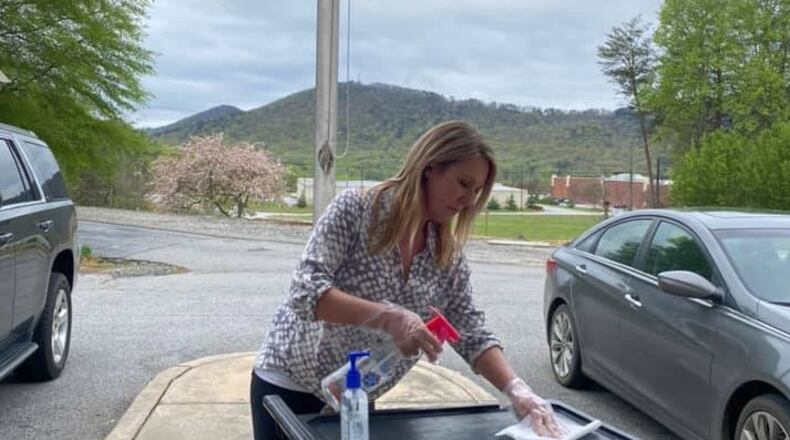With the loosening of Georgia’s stay-at-home rules, more workers are being called back to offices, restaurants and other job sites, but parents of young children cannot go if there is no place that will look after their children.
Most child care centers have closed during the coronavirus pandemic, and those that remained open are operating at reduced capacity due to safety-related restrictions imposed by Gov. Brian Kemp previously.
Now, he is relaxing those rules in the hopes of creating more spots.
The chief change: a doubling of the cap on the number of people — kids and adults — allowed in a classroom. Kemp had imposed a 10-person maximum, but the provisions of his latest order, which took effect today, double that.
"As the economy started to slowly reopen, more and more families started bringing their children back,” said advocate Ellen Reynolds, explaining why child care providers lobbied the governor for the change. "But because you have these group sizes of 10, they ran out of space,” said the CEO of the Georgia Child Care Association. “Doubling it to 20 is going to help tremendously."
There were a couple other minor changes.
The rule for screening children at the front door grew longer, reflecting increased knowledge about COVID-19.
In addition to checking for a temperature over 100.4 degrees and watching for coughing and shortness of breath, operators must now beware of difficulty breathing, chills, muscle pain, sore throat and a newly lost sense of taste or smell.
Another rule − one that requires children to eat in the classroom rather than a lunchroom or some other communal space − got a caveat appended at the end: the rule must only be followed “where possible.”
Although the capacity increase will bolster the child care business and allow more parents to return to the workplace, it is not a return to normal business. Operators will not be able to fill their buildings as in normal times and will not have a space for every parent.
"I had to write a letter to two different employers explaining why I couldn't take their employees’ children,” said Shanda Ginn, the owner and operator of the Cleveland Academy in White County.
The parents were crying, she said.
They were among the parents of eight of Ginn’s 137 enrolled children that she could not squeeze in, even under the new, expanded rules. In addition to the 20-person cap, there are longstanding rules that complicate things, such as mandatory class size ratios that rise with age: there must be at least one teacher for every 8 children aged 1, for instance, so the most Ginn could put into one of those classrooms is 17 children with three teachers or 16 with two.
>> RELATED | Kemp issues safety rules for summer camps, says day camps can open
Half of Ginn's parents had already stopped sending their children by the time of the March order with the 10-person per room cap, but she realized she could not accommodate all 70 who were still coming. So she closed rather than turn some away.
After she saw the order Kemp signed Tuesday doubling the capacity, she can fit and plans to invite them back Monday, though it means leaving those eight parents without a spot.
She’s not happy about that, but she is in a better place than she was in March, when she was unsure her business would survive.
One reason: the federal emergency aid package known as the CARES Act includes grants for childcare operators.
Federal grants for child care centers
Georgia received $144 million, and DECAL is distributing about a third of it to licensed operators based on their enrollment in February.
Ginn applied on the first day, on May 1, and hopes to see the money soon.
But many have not applied, and the deadline is 5 p.m. Friday. This baffles advocates such Polly McKinney, advocacy director for the group Voices for Georgia’s Children.
"The department said everybody who applies for a grant will get some money," she said, adding that the application is easy to fill out through the online platform that operators use to communicate with DECAL.
Despite that, DECAL said that as of Wednesday more than 1 in 4 of the eligible 4,602 child care providers had not applied. Of the $50 million available in the Short Term Assistance Benefit for Licensed Entites program, only $34 million had been claimed.
The only obligation for recipients is to spend the money on their programs. The only reason not to apply is that they don’t need the money, DECAL said.
Reynolds, of the Georgia Child Care Association, fears that either some operators who have closed temporarily aren’t on top of the news and are unaware or that rumors, false she said, that applicants must share their banking records with the state, had discouraged some.
She doesn’t want to contemplate a third possibility, given the long-term consequences for parents who need to work outside the home: “Are people not applying because we've lost those child care centers permanently and they're not coming back?"
In addition to doubling the capacity for classrooms during the COVID-19 pandemic, the Governor’s new child care order contains these 13 rules, most of them identical to his prior order:
- Children must be screened for fever and other signs of illness (the new order lists additional symptoms, such as loss of taste or smell)
- Children with signs of illness must be barred from entering
- "Unnecessary" visitors are prohibited
- Meals should be eaten in the classroom "where possible" (those last two words are new)
- Families are restricted from entering beyond the front door or the classroom door
- Regular sanitizing of frequently-touched surfaces and objects, such as toys, is required
- Toys and games that cannot be sanitized frequently should not be used
- Toys that have been in a mouth or have been otherwise "contaiminated by body secretions or excretions" should be set aside until cleaned by someone wearing gloves
- Machine-washable cloth toys should be used by just one child between washings
- Toys used by a group of children must be washed and sanitized before use by a different group
- Items that need to be cleaned should be put in a dish pan with soapy water
- Cots and mats should be labeled for one child's use; only bedding that can be washed is allowed, and it should be cleaned weekly or before another child uses it
- Computers, keypad systems and pencils or pens used by parents to sign their children in and out must be disinfected after each use
About the Author
Keep Reading
The Latest
Featured



